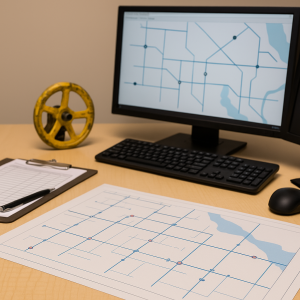
Step into any two water utilities, even neighboring ones, and you’ll notice quickly: no two do things exactly the same way. Valve maps look different. Backflow program procedures vary. Naming conventions for assets can shift from utility to utility — even department to department. This isn’t necessarily a problem. In fact, local knowledge and customized workflows are often sources of strength. But as systems grow more complex and interdependent, a quiet shift is happening in the background: the move toward standardization, not as a top-down mandate, but as a strategic tool for long-term operational resilience.
Standardization, in this context, doesn’t mean stripping away flexibility or turning operators into robots following scripts. Instead, it means creating shared understandings — about what data is collected, how it’s labeled, where it’s stored, and how it’s accessed. It’s about deciding, as an organization, what “normal” looks like — and documenting it.
For decades, many small and mid-sized utilities could afford to operate with looser structures. Staff turnover was low. Equipment was familiar. Regulatory oversight, while always present, was not as granular as it is today. But three developments have started to reshape that reality: the retirement wave among experienced operators, the growing complexity of reporting and compliance, and the increasing number of software and hardware systems introduced into day-to-day work.
Together, these forces are exposing the limitations of systems that rely on “tribal knowledge” — the informal, undocumented habits that allow work to get done but are often invisible to outsiders. When someone who’s worked 30 years retires, they don’t just leave behind a set of tasks — they take with them the mental model of how those tasks relate to everything else. Without a baseline of standardization, their replacement isn’t just starting from scratch — they’re starting blind.
Standardization provides a different foundation. With documented workflows, shared terminology, and clearly mapped responsibilities, transitions become smoother. Errors shrink. Teams spend less time recreating the wheel. And small details — like how a backflow device location is entered or what units are used to log chlorine residuals — no longer become silent sources of confusion or inconsistency.
This matters not just internally, but externally. Regulators, engineering firms, and auditors increasingly expect that water utilities operate with clarity and transparency. When procedures are documented and standardized, reporting becomes faster, inspections become less disruptive, and data quality improves — not because of new tools, but because the inputs themselves are better structured.
And then there’s collaboration. Mutual aid agreements, regional partnerships, and shared services all become more effective when everyone involved speaks the same operational language. A shared understanding of procedures can mean the difference between chaos and coordination during emergency responses or asset failures. As climate-related events, funding pressures, and regional planning continue to push utilities to work together more often, those shared standards become key infrastructure in their own right.
That said, the path to standardization isn’t a single project. It’s more like a mindset. It starts with asking basic, even uncomfortable, questions: Why do we record this reading that way? Why does this form look different depending on who fills it out? Why are five different folders being used to store versions of the same inspection report?
Often, the answers are historical. A supervisor preferred one format. A contractor used a different one. A software tool imposed a default that was never challenged. None of these are failures — they’re the natural results of organic growth. But without examination, they calcify. What started as a helpful shortcut becomes a source of long-term friction.
The goal isn’t uniformity for its own sake. Rather, it’s to develop repeatable, explainable practices that work under stress — whether that stress is a staffing change, a software transition, or an infrastructure failure. It’s also to reduce the operational drag that builds up when inconsistencies compound over time. Every time a field technician has to re-check an address format, or a clerk has to reconcile mismatched device IDs, time is lost — and so is confidence in the system.
Of course, the tools can help. Modern utility management platforms are making it easier to lock in naming conventions, enforce data validation rules, and maintain audit trails. But technology is not a substitute for organizational clarity. A well-configured system built on unclear or conflicting internal processes will still generate noise. A paper system built on thoughtful standards can outperform its digital counterpart.
There’s also a human side to all of this. Standardization can be perceived as bureaucratic or restrictive — particularly among field staff who value autonomy. But the best standardization efforts don’t come from administrators alone. They’re shaped by operators, refined through real-world use, and updated regularly to reflect changing realities. In the end, standardization should feel like support — not surveillance.
Looking ahead, the utilities that thrive won’t necessarily be the biggest, or the most technologically advanced. They’ll be the ones that know how to keep their systems understandable — to themselves, to their successors, to their partners, and to their regulators. In an industry that depends on trust and reliability, that clarity is more valuable than ever.
Standardization may not grab headlines. It won’t show up on the front page of a bond proposal or ribbon-cutting ceremony. But in the background, it shapes every valve turn, every inspection report, and every decision made in the control room. It is, quite literally, how the work gets done — quietly, reliably, and with fewer surprises.
